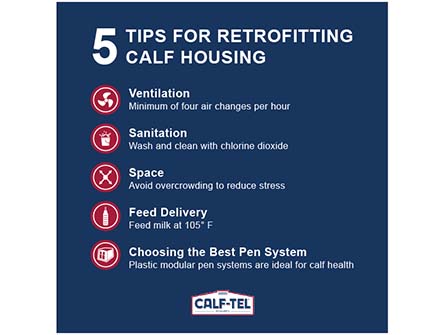Fixer upper: Calf housing edition
Five considerations for retrofitting existing facilities into calf housing.
Germantown, Wis. [June 4, 2019] Indoor calf housing has grown in popularity, particularly in the Midwest where bitterly cold winters make feeding calves in hutches challenging. But building a new calf barn isn’t feasible for everyone.

“Fixing up your old facilities and transforming them into a calf barn can be a cost-effective way to move calves indoors,” said Ben Ekern, Midwest Territory Manager with Calf-Tel.
Here are five considerations for retrofitting existing facilities into indoor calf housing:
1. Ventilation
The first thing to consider when retrofitting an existing facility is ventilation. It’s the most critical component and often the most challenging.
“It has to be done right,” said Ekern. “Getting good air in and bad air out is, without question, of the utmost importance for calf health.”
A minimum of four air changes per hour is ideal to reduce ammonia, minimize bacteria levels and provide a healthy calf environment.
Removing the walls from your existing facility can be a cost-effective way to add natural ventilation and increase air exchanges, but it might not be enough.
“A positive pressure ventilation system can help remove stagnant air and bring fresh air to needed areas,” said Ekern. “Your calves will be thankful you went the extra mile.”
2. Sanitation
Depending on the prior use of the facility you are moving your calves to, it may not be the most sanitary environment. Fully sanitize the facility before you bring in calves. Moving calves is stressful enough without adding contaminants into the mix.
Wash all building surfaces and clean with a sanitizing solution such as chlorine dioxide. While many farmers have bleach readily available, it’s not as effective at killing pathogens and removing biofilms as chlorine dioxide and broader spectrum sanitizers. Let the barn sit empty for at least 5 to 7 days before moving calves in.
Also, when planning your retrofit, consider barn layout for efficient cleaning and sanitation of calf pens.
“If possible, configure the barn to wean the entire barn or section of calves at one time,” said Ekern. “It’s more labor efficient and gives you time to clean, sanitize and let pens sit before new calves move in.”
3. Space
Retrofitted barns don’t always have an ideal footprint for the number of pens or space per pen you need. Overcrowding can cause stress on calves, potentially leading to health issues.
Provide as much space per pen as your facility will allow to keep calves clean and dry and support health. Use existing calf hutches for overflow housing during peak calving times in spring and summer.
“Keeping a row or two of hutches gives you a buffer, so you aren’t overcrowding the calf barn during peak times,” said Ekern. “Hutches are affordable, portable and easy to resell if needed.”
4. Feed delivery
Your delivery method for feeding calves may change once you move indoors. What worked for the hutches may not work in the retrofitted barn.
“Retrofitted facilities might not be equipped with or have space to add a milk house,” said Ekern. “If your milk tank or milk replacer mixing area is too far from the calves, milk temperature may cool down before feeding.”
Have a plan to ensure you’re delivering the proper temperature milk, no matter how far it must travel. You may need to increase the temperature of your mixing water to account for the cooling period during transportation. Use a thermometer to ensure milk or milk replacer is fed at 105 degrees Fahrenheit.
5. Choosing the best pen system
Exposed wood from existing facilities is often used as part of the pen system to cut down on costs. But, wood is porous and can house harmful bacteria, even with a thorough cleaning.
“Any savings from using existing wood can quickly be lost with the extra cost of treating sick calves,” said Ekern. “Make an investment in a plastic pen system for an easier to clean, healthier environment.”
A plastic modular pen system is a great option for retrofitting. Modular pen systems are freestanding and portable. There are no anchors in the cement or costly metal cutting and fitting to lock you into one configuration.
“Retrofitted barns are often a short-term solution before building a new facility down the road,” said Ekern. “A modular pen system can save you money long-term because they can easily move from one barn to the next.”
The Calf-Tel Indoor Pen System helps you make the most of your space for an effective, economical solution to raising calves indoors.
For more information, visit calftel.com or call Ben Ekern at 507-450-1624 to schedule a calf housing audit.
Hampel Animal Care, a division of Hampel Corporation, began serving the agriculture industry in 1981 with the introduction of the Calf-Tel housing system. Today it is the number one choice for calf housing worldwide.
###
